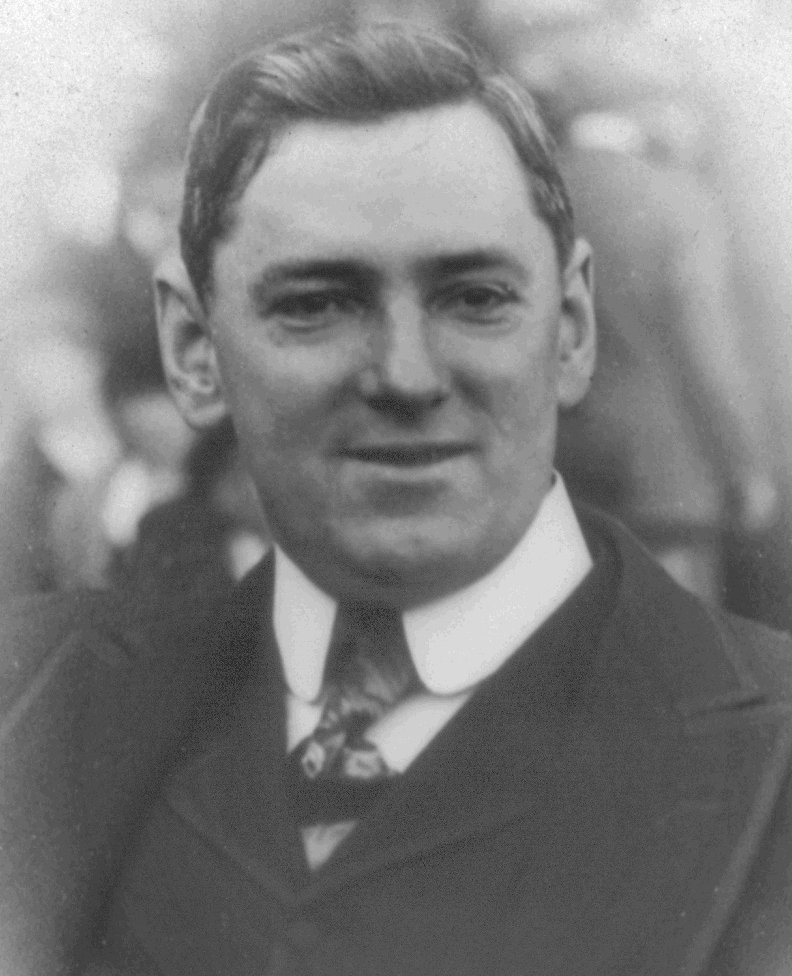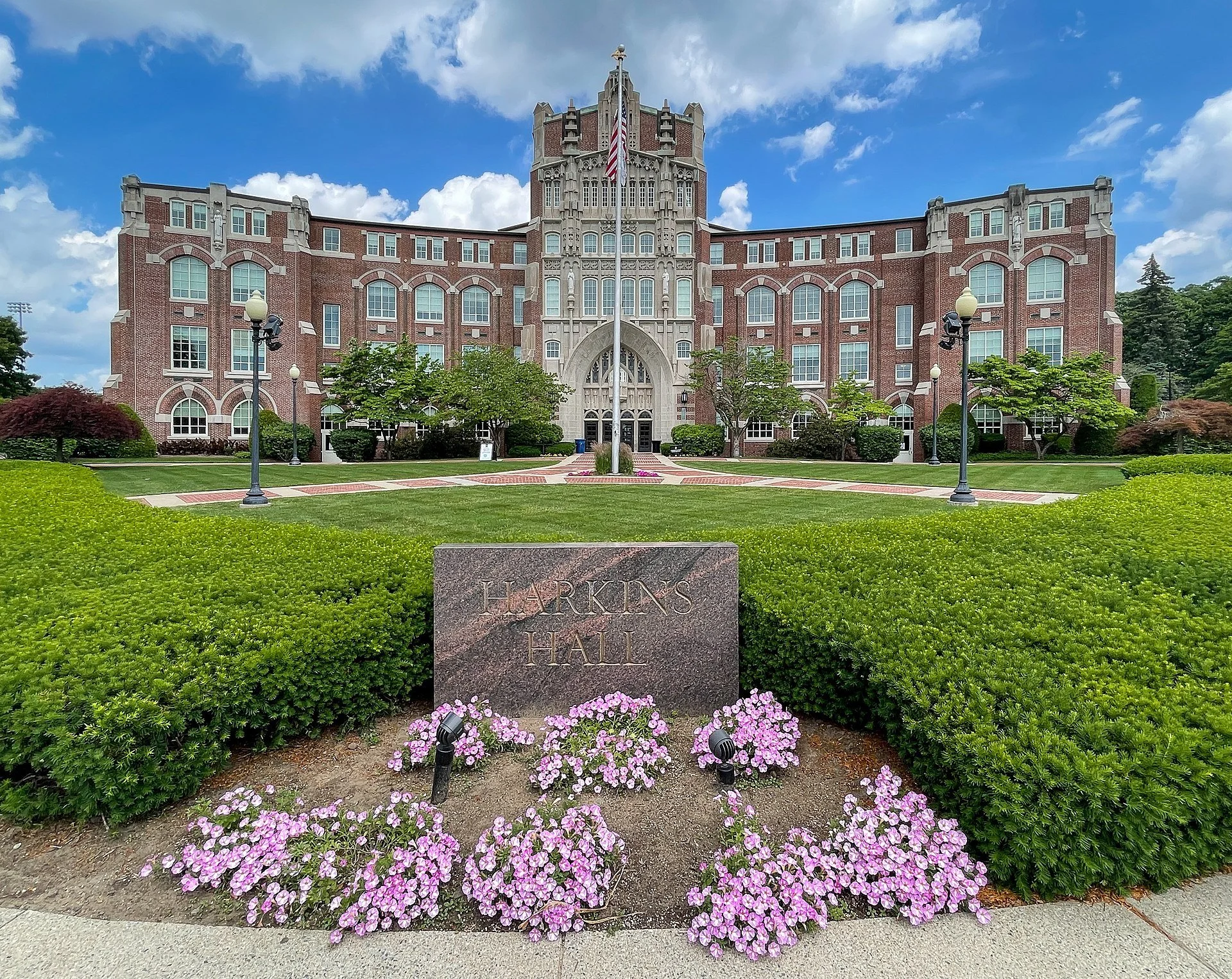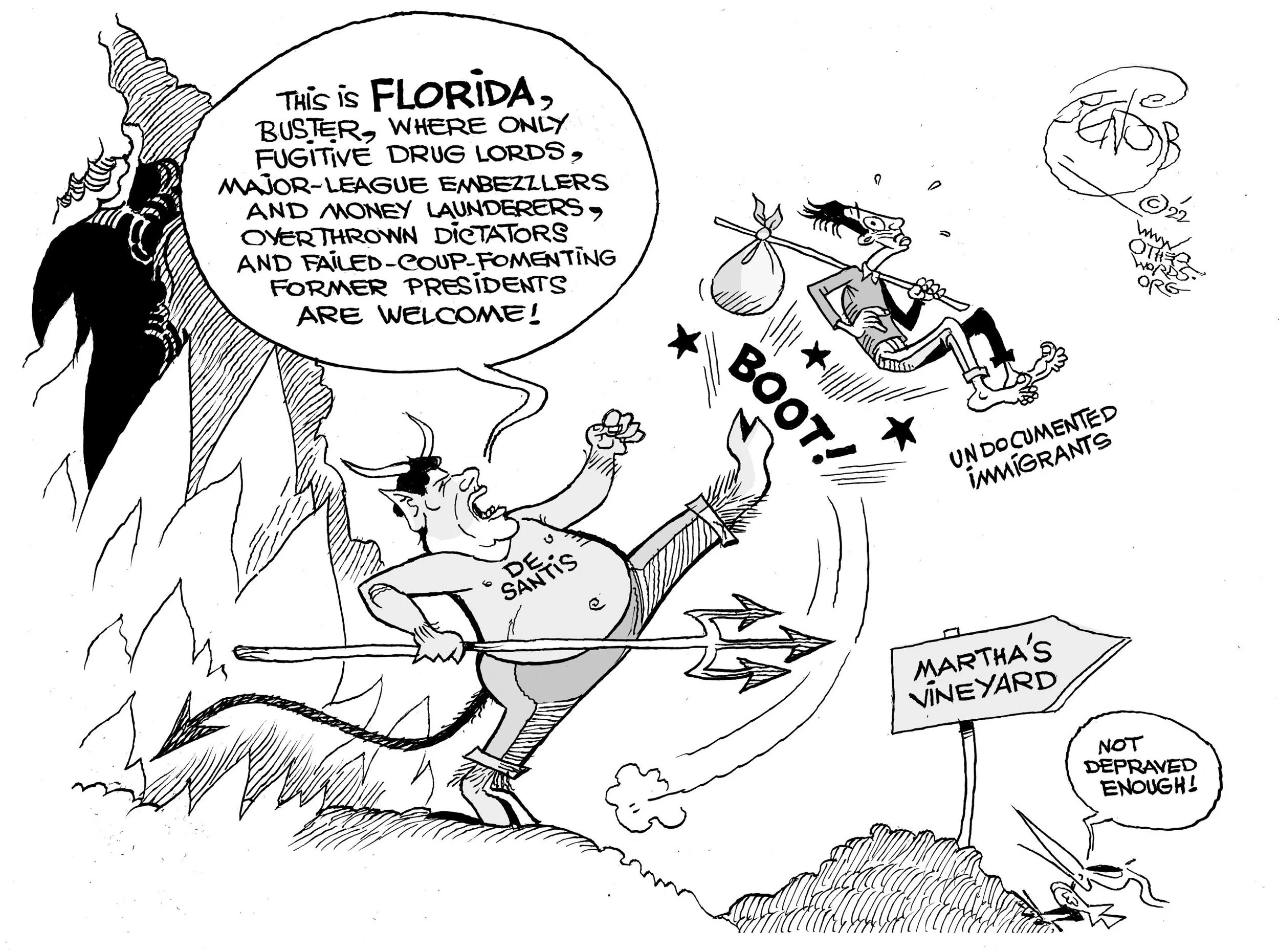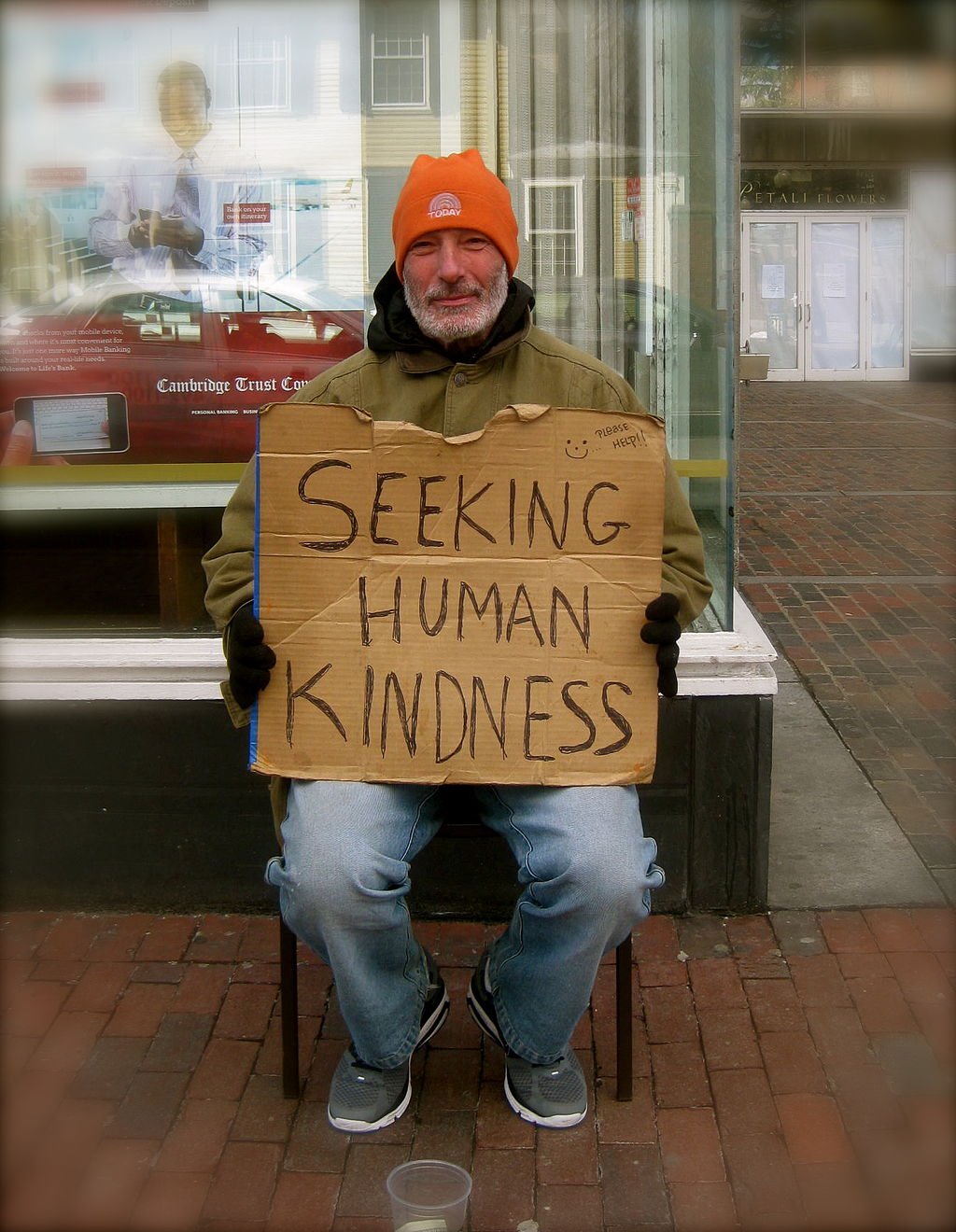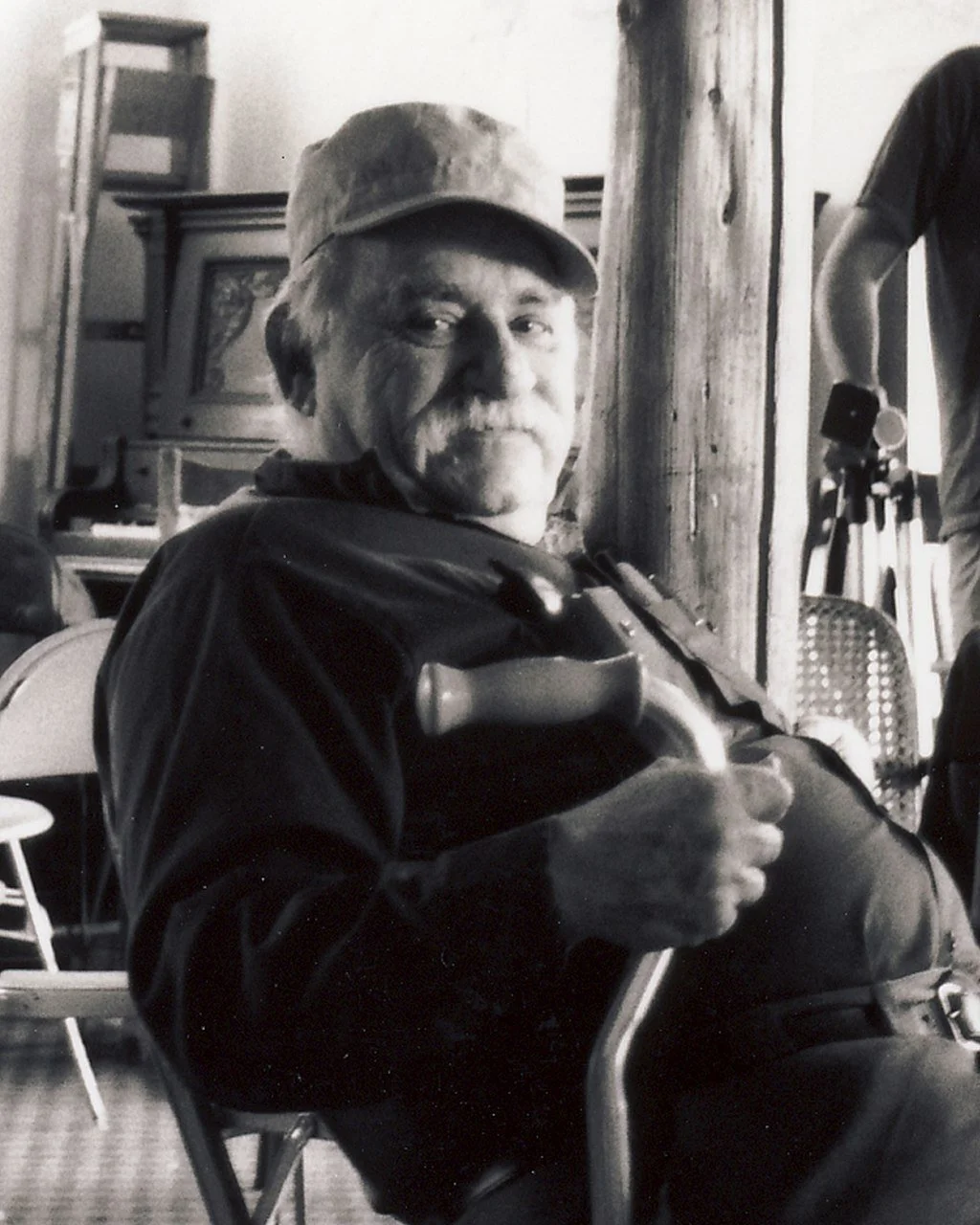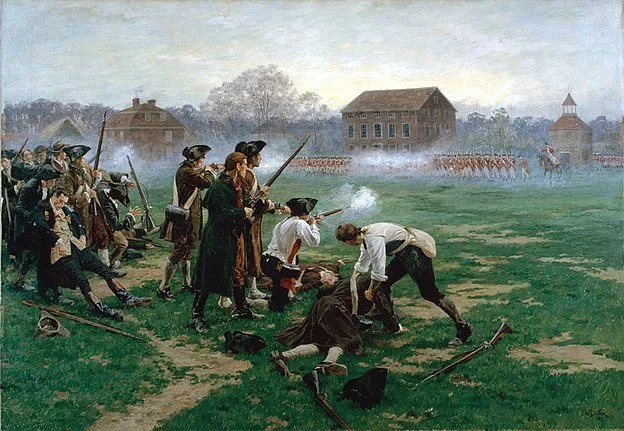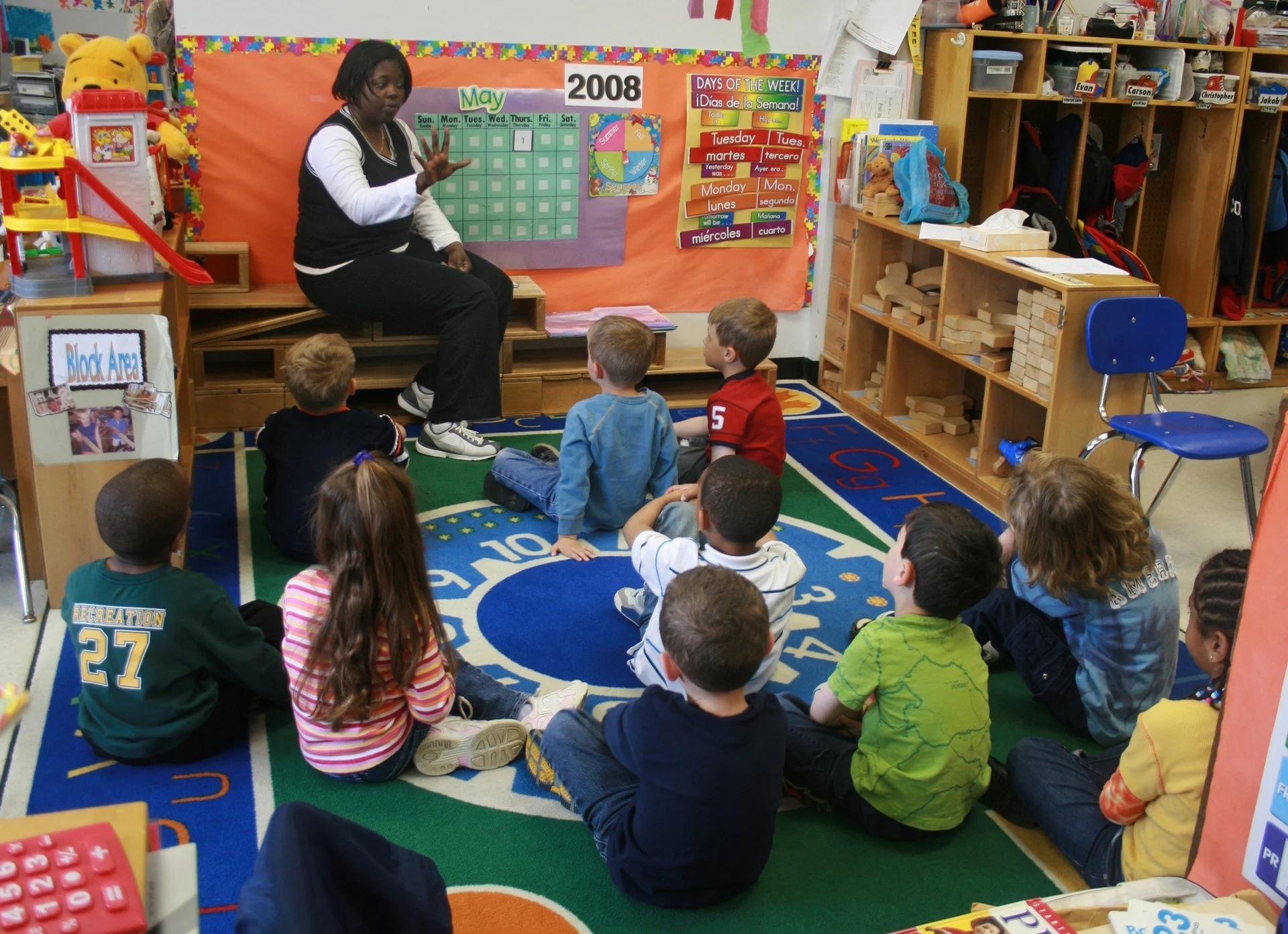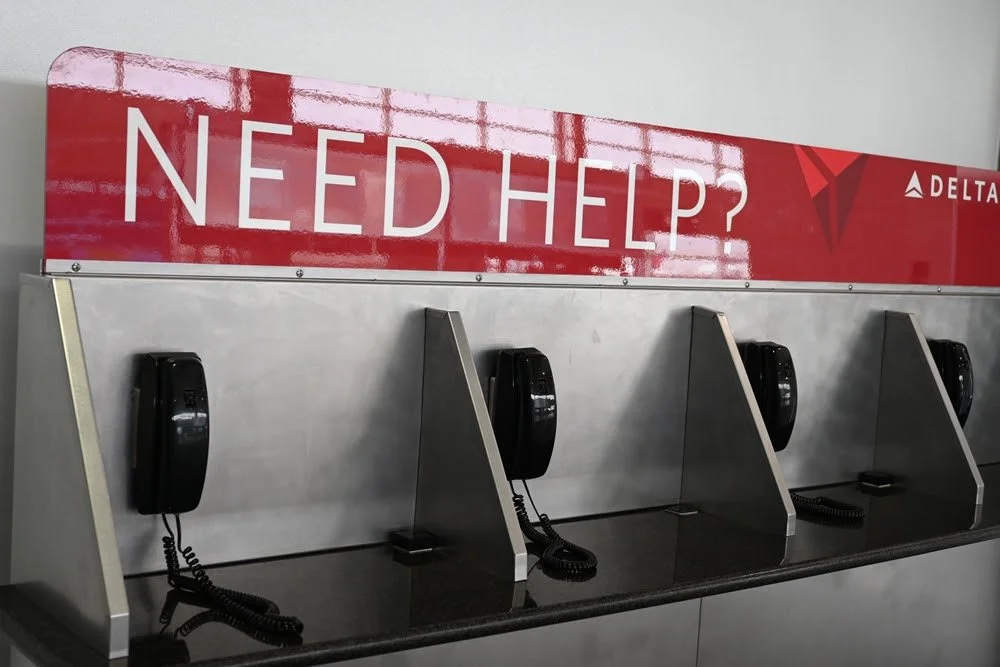
At least it’s ‘systematic’
The corrupt and highly entertaining James Michael Curley (1874-1958), who in his terms as Boston’s mayor skillfully appealed to the resentments of city’s Irish-American residents about the “Boston Brahmin” WASP elite. He was the basis of Edwin’s O’Connor’s great novel The Last Hurrah.
Editor’s note: My paternal grandfather first met Curley in 1930, when they had a conversation of about 10 minutes. He next encountered him in 1949. Curley asked after my grandmother and her two children by name and other related family stuff. Like most great pols, he had a capacious memory for personal information about current and potential voters.
“Politics, as a practice, whatever its professions, had always been the systematic organization of hatreds, and Massachusetts politics had been as harsh as the climate. The chief charm of New England was harshness of contrasts and extremes of sensibility —a cold that froze the blood, and a heat that boiled it —so that the. pleasure of hating—oneself if no better victim offered —was not its rarest amusement; but the charm was a true and natural child of the soil, not a cultivated weed of the ancients. The violence of the contrast was real and made the strongest motive of education. The double exterior nature gave life its relative values. Winter and summer, cold and heat, town and country, force and freedom, marked two modes of life and thought, balanced like lobes of the brain. Town was winter confinement, school, rule, discipline; straight, gloomy streets, piled with six feet of snow in the middle; frosts that made the snow sing under wheels or runners; thaws when the streets became dangerous to cross; society of uncles, aunts and cousins who expected children to behave themselves, and who were not always gratified; above all else, winter represented the desire to escape and go free. Town was restraint, law, unity. Country, only seven miles away, was liberty, diversity, outlawry, the endless delight of mere sense impressions given by nature for nothing, and breathed by boys without knowing it.’’
Henry Adams (1838-1918), in The Education of Henry Adams (1918). He was a member of the famous Boston] area-based Adams political family that started with President John Adams.
N.E. clean-energy update
2007 U.S. Department of Energy wind resource map of Rhode Island
Adapted from Robert Whitcomb’s “Digital Diary,’’ in GoLocal24.com
I wonder how Newporters and tourists will respond to the sight on the horizon of 100 offshore wind turbines to be put up by Revolution Wind about 15 miles south of Little Compton. And there are other big offshore “wind farms’’ in the works south of New England. The Revolution Wind turbines will be the closest to Rhode Island.
There will be complaints from some folks who don’t want to look at them, even from a distance, but most people will get used to them fast, as they generally do with big new infrastructure. And many think that the giant turbines, of the sort that have long been spinning along the coasts of Europe, are beautiful. (Thank God the Europeans have been much more decisive than us in putting up wind farms, thus reducing their reliance on Russian fossil fuel, which is used to finance Putin’s mass murder and torture in Ukraine.)
Some yachtsmen will complain about the wind farms, saying that they’ll cramp their summer racing and cruising, as will some fishermen. But many of the latter may come to appreciate that wind-turbine supports act as reefs that attract fish.
In any event, I’m sure that some boat-owning entrepreneurial types will sell tickets to take tourists from Newport to see these things close up, with blades rotating to a height of 873 feet as they cleanly, if eerily, generate electricity.
xxx
Connecticut has opened its first electric-car-charging operation on its stretch of Route 95 (aka the Connecticut Turnpike), at its Madison service plaza. And more are coming.
“Seaglider’’
— Regent picture
Finally, the folks at Regent tell me that its electric “seaglider” achieved its first series of flights on Aug. 14 on Narragansett Bay, “proving its full ‘float, foil, fly’ mission—making it the first craft to take off from a controlled hydrofoil to wing-borne flight.’’
The demonstrator is a quarter-scale prototype for its 12-passenger seaglider, Viceroy.
The company calls the seaglider “a new category of electric vehicle that operates exclusively over the water, is the first-ever vehicle to successfully use three modes of maritime operation—floating, foiling and flying—marking a major step forward in maritime transportation.’’
Regent is now focusing on developing its “full-scale, 65-foot wingspan prototype, with human-carrying sea trials expected to begin in 2024.’’
Hit this link for a video. (No, Regent doesn’t pay me.)
Soft to rough
“Charlotte” (Italian marble,) by Scott Boyd, in the show “Rock Solid XXII,’’ through Oct. 29, at Studio Place Arts, Barre, Vt., in the heart of Vermont’s granite quarrying and finishing region. (Think of the Rock of Ages Corporation’s gravestone and other products.) The state is also the source of high-grade marble.
— Photo courtesy: Studio Place Arts.
The gallery says that the exhibit “showcases the work of 20 sculptors whose work in stone is able to bring out all of the qualities of the medium — from delicate flowing sculptures that turn stone into something that looks as soft as silk to rough pieces that emphasize the rugged nature of the material.’’
The entrance to the Vermont Marble Museum, in Proctor. The Green Mountain State has been a major source of marble as well as granite.
— Photo by GK tramrunner
Rock of Ages granite quarry
— Photo by Z22
Llewellyn King: Remembering a real hero in these carping times
Chuck Yeager in front of the Bell X-1, which, as with all of the aircraft assigned to him, he named “Glamorous Glennis” (or some variation thereof) after his wife.
WEST WARWICK, R.I.
Winston Churchill used to advise young people to read “Bartlett’s Familiar Quotations,” the oft-updated compilation of brief quotes from just about anyone who said something memorable. Of course, Churchill added more than a few of his own. He may have added more to the storehouse of aphorisms than any writer since Shakespeare.
But others have been no slouches. If you want to go back a bit, Napoleon wasn’t unquotable, and such writers as George Bernard Shaw and Oscar Wilde were prolific with wit and wisdom served up in brevity. Mark Twain was a treasury of quotable sayings all by himself. In our time, Steve Jobs made some pithy additions and Taylor Swift, in her lyrics, has some arresting and quotable lines.
The quote to me is distilled wisdom in a few words, often funny, whether it came from Dorothy Parker, Abraham Lincoln or the Beatles. A picture may be worth a thousand words, a quote believed to have been first formulated by the Norwegian playwright Henrik Ibsen, but a well-chosen aphorism is worth many more than a thousand words.
So, it is thrilling to know that Victoria Yeager, widow of Chuck Yeager, aviation’s greatest hero, has collected his sayings into a book, 101 Chuck Yeager-isms: Wit & Wisdom from America’s hero.
Yeager came from the small town of Hamlin, W. Va. Even today it has a population of just over 1,000. Being from one of West Virginia’s famous hollows, Yeager said of it, “I was born so fer up a holler, they had to pipe daylight in.”
When the town erected a statue of Yeager, he said, “There wasn’t a pigeon in Hamlin until they erected a statue of me.”
The journey began modestly with Yeager joining the U.S. Army as a private after high school and led on to his success as fighter ace with 11.5 kills – one involved another U.S. aircraft and, hence, the half -- but Victoria Yeager told me that here were more not officially recognized. He may have shot down as many as 15 German aircraft over Europe, she said.
He was shot down himself over France in 1944; Germans watched his parachute float down and went out to find him. Yeager said, “There ain’t a German in the world that can catch a West Virginian in the woods.” And they didn’t.
In an interview for White House Chronicle, on PBS, Victoria told me that Yeager always insisted that there be fun in everything, whether it was aerial fighting, flying through the sound barrier, or flying aircraft that might kill him. “You gotta have fun in life, whatever I did, I always included fun,” he said.
Yeager, Victoria said, maintained critical aircraft like the X-1, in which he broke the sound barrier, himself. That way he knew and there would be no excuses. He said, “In the end, or at the moment of truth, there are only excuses or results.”
Victoria told me that the impression given in the movie The Right Stuff of Yeager as a reckless daredevil who rode a horse up to his aircraft, took off, and broke the sound barrier was pure Hollywood. Yeager was a consultant to Tom Wolfe during the writing of his book The Right Stuff to ensure accuracy. In fact, Victoria said, it was on the ninth flight that he broke the sound barrier. It is true that the horizontal stabilizer on the plane wasn’t working, but Yeager was able to control the plane with a manual trim tab, she added.
Yeager fought in World War II because, as he saw it, it was his duty to fight, as he saw it. After being shot down he wanted to keep fighting; and when the military wanted to send him home, he appealed the decision all the way up to Dwight Eisenhower, then the supreme allied commander in Europe, and won the right to fly in combat again. He said of duty, “You’ve got a job to do, you do it, especially in the military, when I was picked to fly the X-1, it was my duty to fly it, and I did.”
Yeager’s philosophy may have been summed up in this quote, “You do what you can for as long as you can, and when you finally can’t, you do the next best thing; you back up, but you don’t give up.”
That is the spirit that kept Yeager flying for pleasure up to close to his death, at 97.
In our carping, whining, blaming times, it is a tonic to read the thoughts and something of the life of a real hero. Thank you, Victoria Yeager, for assembling this book.
Llewellyn King is executive producer and host of White House Chronicle, on PBS. His email is llewellynking1@gmail.com and he’s based in Rhode Island and Washington, D.C.
Linda Gasparello
Co-host and Producer
"White House Chronicle" on PBS
Mobile: (202) 441-2703
Website: whchronicle.com
Providence College’s new school
Harkins Hall (1919) at Providence College, designed by Matthew Sullivan in the Collegiate Gothic style
— Photo by Kenneth C. Zirkel
Edited from a New England Council (newenglandcouncil.com) report
BOSTON
“New England Council member Providence College has opened its fifth school, the School of Nursing and Health Sciences. This new school will achieve a goal set by PC’s president, the Rev. Kenneth Sicard, in his inaugural address, on Oct. 1, 2021.
“The new school will expand Providence College’s academic programs in a field that’s crucial to address the shortage of health-care workers in New England and the rest of the United States. In keeping with the college’s liberal-arts tradition, the curriculum included input from faculty from multiple disciplines. Community members wanted to ensure that the new cohort of students will think critically while studying health care to gain skills to help not only the physical but the mental and spiritual well-being of their future patients. The new school will allow students to step outside their normal course load to be able to study abroad, explore dual-language courses and complete immersive community experiences. PC will begin admission to the new school in the fall semester of 2023.
“Christopher Reilly, chairman of the college’s board of trustees, said, ‘These academic initiatives will enhance Providence College’s impact on society in ways that honor the institution’s mission and heritage. They will create exciting opportunities for our students, guided by our faculty, to prepare for lives of meaningful service in assistance to our neighbors and our communities.”’
Vertigo on the Merrimack
“Palms” (print), by Tewksbury, Mass.-based artist Diane Francis, in the show “Printmaking: From Silly Putty to Silkscreen,’’ at the Arts League of Lowell (Mass.) through Oct. 30.
— Photo courtesy: Arts League of Lowell.
The gallery says that the show features the work of printmakers who span the gamut of styles and techniques. Each artist in the show brings their own spin to the centuries-old medium.
Lowell in 1876, in its industrial heyday.
Tewksbury Hospital is a National Register of Historic Places-listed site on an 800+ acre campus in Tewksbury. The centerpiece of the hospital campus is the impressive 1894 Richard Morris Building ("Old Administration Building") above.
The Massachusetts Department of Public Health runs a 350-bed facility at Tewksbury Hospital, providing medical and psychiatric services to adult patients with chronic conditions. The Public Health Museum in Massachusetts now occupies the Richard Morris Building.
In addition to the hospital and museum, the campus also hosts eight residential substance-abuse programs. Five state agencies have regional offices at Tewksbury, including the Massachusetts Department of Mental Health and the Massachusetts Department of Public Safety. The campus also hosts several non-profit and for-profit private entities, including the Lahey Health Behavioral Services' Tewksbury Treatment Center, Casa Esperanza's Conexiones Clinical Stabilization Services (CSS), the Lowell House's Sheehan Women's Program, the Lowell House Recovery Home, the Middlesex Human Service Agency and the Strongwater Farm Therapeutic Equestrian Center.
Trying to grow bigger trees
In the Great North Woods of northern New Hampshire. The area is famed as a source of lumber and wood pulp for paper-making.
— Photo by Will Leavitt
Adapted from an item in Robert Whitcomb’s “Digital Diary,’’ in GoLocal24.com
The U.S. Department of Agriculture is funding a $30 million pilot program to encourage New England forest owners to help address global warming by growing bigger trees, which store more carbon and provide better wood for the building, furniture and other industries than smaller ones. The program, of course, will have the biggest impact on Maine.
The New England Climate Smart Forest Partnership Project is one of 70 department projects aimed at absorbing carbon from greenhouse-gas emissions.
This project includes “pre-commercial thinning” of trees to let the surviving trees grow larger and faster. Sounds reasonable, but this won’t please wildlife that thrives in areas that are thick with smaller trees and bushes. Indeed, the clearing of strips of forest for electricity lines and fire breaks creates ecosystems for many animals.
Shailly Gupta Barnes: Census data show that anti-poverty programs work
Homeless man in Boston
— Photo by Enver Rahmanov
The Town Farm, in Easthampton Mass. Now called the Easthampton Lodging House, it’s an historic poor farm at 75 Oliver St. It was established in 1890 as an inexpensive way to provide for the town's indigent population, and is the only locally run facility of its type to survive in the state. The property was listed on the National Register of Historic Places in 1996. Poor farms, which housed the penniless, some of whom paid for this with farm work, were a feature of many New England communities into the 20th Century.
— Photo by John Phelan
Via OtherWords.org
The U.S. Census Bureau recently reported that poverty dropped notably in 2021. Amid a pandemic and widespread economic pain, this is a significant accomplishment.
There are three lessons here — about government programs, about how we measure poverty, and about how far we have left to go.
First, these numbers show that government programs work. After Social Security, refundable tax credits like the expanded Child Tax Credit (CTC) and stimulus payments were the biggest contributors to reducing poverty.
Without them, over 20 million more people would have been poor last year. The expanded CTC alone lifted millions of children above the poverty line and reduced racial inequities among poor children.
These programs worked because they departed significantly from how anti-poverty programs have worked for the past 30 years. They provided direct cash transfers to recipients, without any work requirements or bureaucratic indignities.
Welfare-rights organizers have been pushing for these changes for decades. This year, they were proven right.
But unfortunately, official federal poverty figures still conceal the true number of people who are struggling — and underestimate the scale of our responsibility to help them.
At just $31,000 for a family of four, the federal government’s Supplemental Poverty Measure, or SPM, is far too low. That’s less than half of the typical cost of living for a family this size in rural Mississippi, or just one-third for Chicago. And the official poverty measure, or OPM, is even lower.
I’m the policy director of the Poor People’s Campaign, which defines poverty to include everyone living up to 200 percent of the SPM.
Using this measure, which is still less than median income, we counted 140 million people — or 43 percent of the country — who were poor or one emergency away from being poor before the pandemic. In 2021, this rate went down to about 34 percent, or 112 million people.
This is a significant decrease. But it means over a third of our nation has little to celebrate.
In fact, the population living between 100 percent and 200 percent of the SPM threshold stayed basically the same between 2020 and 2021: nearly 90 million people, just one emergency away from poverty. If we only looked at the poverty rate, we would have missed them entirely.
That means we can and must do more. The expanded CTC expired in December 2021, and there has been no further discussion of reviving stimulus payments — even with the federal minimum wage at its lowest value in 66 years and the cost of living continuing to rise.
This is not to minimize the gains we’ve made. They just remind us that poverty is a policy choice — and fortunately, we can make different choices.
In 2020, there were over 80 million eligible poor and low-income voters. Fifty million of them voted in the presidential contest, accounting for a third of the electorate overall and even higher percentages in key states in the Midwest and South.
These voters share a common interest in securing health care, living wages, decent housing, and safe schools for their kids. If they could be organized to take action together — across race, religion, and other lines of division — we could advance the moral policies we need to fully address poverty.
“What’s hurting me in Kentucky is hurting you in Alabama, in West Virginia, and across the nation,” said Tayna Fogle, a leader in the Kentucky Poor People’s Campaign, earlier this year.
“Can you imagine all the poor and the low-income people coming to the ballot box?” she asked. “What if we did everything we could to make sure that our vote counted? We could overturn this madness that’s going on.”
If poor people vote in the midterms like they did in 2020, we could make another leap towards ending the madness of widespread poverty in the midst of plenty.
Shailly Gupta Barnes is the policy director for the Poor People’s Campaign: A National Call for Moral Revival and the Kairos Center.
Antler art
Basket by Maine artist Sarah Sockbeson at the Portland Museum of Art.
The museum says:
Her work “offers insight into Wabanaki basketry as an ever-evolving art form. The incorporation of deer antler, which Sockbeson cuts, carves, and polishes herself, has emerged as a kind of signature—her personal inflection to a practice that both upholds and updates established techniques.’’
The Abenaki are an indigenous people of the Northern Woodlands of Canada and the United States. They are an Algonquian-speaking people and part of the Wabanaki Confederacy. The Eastern Abenaki language was predominantly spoken in Maine, while the Western Abenaki language was spoken in Quebec, Vermont and New Hampshire.
Dark green shows the territory of the Eastern Abenaki.
So there’s no uranium mining in Vermont
Murray Bookchin, who moved to Vermont from New York City.
“You see my residence is in New England, and New England has a strong tradition of localism. What is ordinarily called election day in most of the United States is called town meeting day in Vermont. And there are town meetings that are to one degree or another active, however vestigial their powers. They, for example, banned uranium mining in the Green Mountains of Vermont. And the governor of the state was forced to knuckle down to that even though he wanted uranium mining. A number of town meetings—not very large a number but at least a majority of those who had it on their agenda—voted for a nuclear arms moratorium. They’re taking up issues like that at town meetings. What we would like to do if we could is foster, at least in Vermont, greater local power, discussions around issues that are not simply immediate local issues. We would like to raise broad issues at these town meetings and turn them into discussion arenas and interlink the various assemblies and town meetings or try to help create growth of this type of local municipal power—communal power—a view toward, very frankly, establishing a grass-roots self-management institutional framework or network. Now this may be a pure dream, a hopeless ideal, but it’s meaningless for us to go to factories, I can tell you that much.’’
— Murray Bookchin (1921-2006), author, democratic socialist, writer and environmentalist.
Surprise airborne invasion
“Soft Landing” (encaustic collage, ink), in the large group show “Flights of Fancy,’’ at Gallery Twist, Lexington, Mass., through Oct. 16.
William Barnes Wollen’s painting of the Battle of Lexington, which took place on April 19, 1775. With the Battle of Concord the same day, it was the start of the American Revolutionary War (1775-1783)
It’s at the National Museum of the U.S. Army, in Fort Belvoir, Va.
Including our diminished things
An Ovenbird
— Photo by Christoph Moning
There is a singer everyone has heard,
Loud, a mid-summer and a mid-wood bird,
Who makes the solid tree trunks sound again.
He says that leaves are old and that for flowers
Mid-summer is to spring as one to ten.
He says the early petal-fall is past
When pear and cherry bloom went down in showers
On sunny days a moment overcast;
And comes that other fall we name the fall.
He says the highway dust is over all.
The bird would cease and be as other birds
But that he knows in singing not to sing.
The question that he frames in all but words
Is what to make of a diminished thing.
— “The Ovenbird,’’ by Robert Frost (1874-1963). Ovenbirds breed in New England, among other north temperate zone areas, and winter around the Caribbean.
David Warsh: To come back, print editions of newspapers must solve intricate production problem
SOMERVILLE, Mass.
The off-lead story in the Sept. 18 New York Times, illustrated by a fraying American flag, was one of a series: “Democracy Challenged: twin threats to government ideals put America in uncharted territory.” Senior writer David Leonhardt identified two distinct perils: a movement in one major party to refuse to accept election defeat, and a Supreme Court at odds with public opinion. Leonhardt’s argument was well reasoned and deftly written, enough to fill four pages after the jump.
To my mind, though, The Times is overlooking a problem even more fundamental to the conduct of American democracy: the concentration of power in the quartet of daily newspapers that remain at the top of the first-draft-of-history narrative chain. The loss of diversity of news and opinion among metropolitan newspapers in the 50 American states over the last thirty years has not been well understood.
Media proprietor Rupert Murdoch bought The Wall Street Journal from the Bancroft family, in 2007. Amazon founder Jeff Bezos bought The Washington Post from the Graham family, in 2012. Japanese media group Nikkei acquired the Financial Times from Pearson publishers, in 2015. The New York Times, a fifth-generation family-controlled firm, retains its independence. But Bloomberg LP, an all-digital software analytics and media company, also based in midtown Manhattan, remains looking over its shoulder.
Meanwhile, major metropolitan daily newspapers across the country have been sold and diminished, or collapsed altogether, in the 32 years since the World Wide Web was introduced. These include the Chicago Tribune and its many subsidiaries, among them the Los Angeles Times, The Baltimore Sun, The Hartford Courant and the New York Daily News; The Providence Journal; The Philadelphia Inquirer and 31 other Knight Ridder newspapers, including The Miami Herald and San Jose’s Mercury News; Cleveland’s Plain Dealer, Portland’s Oregonian and New Orleans’s Times-Picayune, among the Newhouse newspaper chain; the Louisville Courier-Journal; the Arizona Republic; Las Vegas Sun, and Dean Singleton’s Denver Post. The Daily Bee, founded in Sacramento in 1857, part of all but the last surviving family-owned newspaper chain, declared bankruptcy in 2020, though the Atlanta Journal-Constitution remains the flagship of Cox Enterprises. Only Texas and Florida maintain several competitive metropolitan newspapers. The Christian Science Monitor ceased publishing a paper edition in 2009, while maintaining a digital presence.
What happened? Google and Facebook entered the advertising business. Antitrust newsletter writer Matt Stoller recently described Google’s rollup of the search-intermediary industry over the course of a decade, notably its 2007 acquisition of DoubleClick, into the voracious advertising sales business that the former “free” search engine enterprise has become. Facebook did much the same. The result was that newspapers lost some 80 percent of their advertising revenues in a decade. More than 2,000 papers went out of business altogether.
In a similar vein, The New Goliaths: How Corporations Use Software to Dominate Industries, Kill Innovation, and Undermine Regulation (Yale, 2022), by James Bessen, makes a compelling case that “dominant firms have used proprietary technology to achieve persistent competitive advantages and persistent market dominance,” by more effectively managing market complexity in industries of all sorts.
Strengthening antitrust enforcement is a good idea, Bessen says, but breaking up firms is unlikely to solve the “superstar problem.” A more effective solution has to do with opening up access to knowledge, which means addressing ubiquitous intellectual-property bottlenecks. Market-driven unbundling – the process that, in the 1970s, led IBM to open its proprietary software to independent applications, and, in the Oughts, Amazon to make its information technology software available to other vendors on its proprietary servers – offer more promising possibilities, he asserts in a closing chapter. Bessen heads a research initiative at Boston University’s Law School. The New Goliaths is an important book. Let’s hope it get the attention it deserves.
American democracy is not doomed to a future dominated by four or five national newspapers. There is reason to believe that the market for home-delivered newsprint newspapers is much broader than it now seems, though it may take years to revive it. Radio returned to prosperity after television advertising all but destroyed its formerly lucrative advertising business. Newsprint thrived for nearly a hundred years despite the entry of both.
To come back from the online onslaught, however, print newspapers must solve an intricate coordination problem, involving every aspect of the business. These include the cost of newspaper production, from newsprint to software to printing facilities; the riddle of subscription pricing; the restoration of home delivery networks; and the reconstruction of advertising sales. Moreover, the new newsprint goliaths must cooperate with big city dailies seeking to regain market share if the problem is to be solved.
Take, for example, a narrow slice of the cost of production problem: the software that enables editors to simultaneously assemble and publish both print and online content. Dan Froomkin, a former Washington Post columnist, reports in The Washington Monthly, that Amazon’s Bezos, upon acquiring The Post, discovered that the process was wildly inefficient, whereupon he tasked chief information officer Shailesh Prakesh to fix it.
The result: a best-in-class publishing platform, Arc XP, that the Post now uses to publish its own product, and licenses to 2,000 other media and non-media sites. But the license, Froomkin says, is expensive. His suggestion: that Bezos do as Andrew Carnegie did with his libraries more than a century ago, and make Arc XP available free to other newspaper publishers, along with its companion Zeus Technology ad-rendering platform. It is an interesting proposal. So is the multi-state antitrust lawsuit against Google and Facebook, slowly making its way in a U.S. District Court. Meanwhile, the bipartisan Journalism Competition and Preservation bill inched forward last week, when the Judiciary Committee voted 15-7 to send it to the Senate floor
What size might be the market for subscriber-based print, supplemented by traditional advertising? At what annual price? There is simply of no way of telling besides customary trial and error. Let’s hope that the new newsprint goliaths will participate in the learning. True, the four national papers and Bloomberg do a pretty good job of gathering news on their own. But it seems clear that the American democracy functioned better when there were more strong voices scattered across its landscape. It makes sense to search for ways by which those circumstances can be restored – plenty of fodder for future columns.
David Warsh, a veteran columnist and an economic historian, is proprietor of Somerville-based economicprincipals.com.
Editor’s note, a few newspapers, most notably in New England The Boston Globe, now under control of the Boston-based Henry family, still retain much, but far from all, of their former journalistic package.
Chris Powell: Conn. GOP’s ‘Parental Bill of Rights’ should be just the start
— Photo by woodleywonderworks
MANC HESTER, Conn.
Call it an opportunistic feint in the "culture war" if you want, but the "Parental Bill of Rights" proposed the other week by the Republican nominees for Connecticut governor and lieutenant governor, Bob Stefanowski and state Rep. Laura Devlin, raises important issues that Connecticut should stop evading.
Several of the Republican proposals are vague. The Republicans say that they oppose presenting sexual topics to the youngest students but don't specify an age or grade at which sex education in school becomes appropriate. Of course, this vagueness is not likely to protect the Republicans from the Democratic demagoguery that in Florida misrepresents the state's fourth-grade threshold as a "Don't Say Gay" law.
The Republicans oppose student masking and vaccination requirements that deny parents "any recourse to object," but that recourse isn't defined either. Should Connecticut reinstate a religious exemption from vaccination of students for the basic childhood diseases? The Republicans don't say.
The Republicans call for expanding school choice for students in underperforming schools and endorse vouchers in principle. Would church schools qualify for these initiatives with government money?
While the long decline in public education's performance argues strongly for making church schools eligible, especially in the cities, again the Republican candidates aren't clear. Gov. Ned Lamont contends that state government's system of magnet schools provides sufficient choice, but in a recent court settlement his administration admitted that the system is not sufficient, that it is unable to meet demand for escape from many failing schools and should expand. Meanwhile, Catholic schools have been closing even as the need for their old competence and economy has exploded.
The Republicans propose spending a lot more money on tutoring students whose education was set back the most by the closing of in-person schooling during the virus epidemic. The Republicans also propose spending more to secure schools against attack. The Republicans don't say exactly where the money should come from, but then as state government rolls in billions of dollars of free federal money, the Democrats don't care much about where money is to come from either.
At least the Republicans are specific in calling to prohibit biological males from competing in girls sports in public schools. But the Republicans frame this as a matter of safety when it is really a matter of fairness, of preserving equal opportunity for girls under Title IX of federal civil rights law.
No matter, since Democratic demagoguery here will accuse the Republicans of "transphobia" and worse, even as Governor Lamont is trying to dodge the issue by contending that policy on transgender athletes should be left to local option -- that is, that the rights of female students should vary among school systems, even as many high school sports events involve two or more towns that could have contradictory policies.
The Republicans dodge a little here too, saying that some mechanism should be developed so that boys wanting to be girls can keep competing. But of course they already can compete in events for their biological sex.
Unfortunately omitted from the Republican proposals is any reference to the policies of deception already adopted by school systems in Hartford, New Haven and some other places in regard to students with gender dysphoria. Such policies forbid schools from notifying parents if their children are getting their school's help in changing their gender identity and names, unless the children approve of informing their parents.
Such policies usurp parental custody, may prevent parents from controlling the medical treatment of their children, and may cause critical delays in treatment before irreversible harm is done.
While such policies have been adopted nominally in the open, at public meetings, they have not been widely publicized and, at least in Hartford and New Haven, not directly publicized to parents at all. That's because any school that made sure that parents fully understood that they will be kept ignorant about the health of their children might face much angry objection.
Of all the rights parents have or should have, none is greater than the right to know exactly what schools are doing with the health and very identities of their children.
Chris Powell is a columnist for the Journal Inquirer, in Manchester, Connecticut. He can be reached at CPowell@JournalInquirer.com.
The Dr. Daniel Lathrop School is a historic school building at 69 East Town St., in the Norwichtown section of Norwich, Conn. It faces the village green next to the Joseph Carpenter Silversmith Shop, another historic building. Built in 1782, the school building is one of the oldest surviving brick school buildings in the state. The building, on the National Register of Historic Places, now serves as a visitors center for the local historical society.
— Photo by CLK Hatcher
Where problems seem small
Brenda Horowitz, “High View” (acrylic on canvas), by Brenda Horowitz, at Berta Walker Gallery, Provincetown, Mass. Now 90, she’s based in New York City and North Truro, next to Provincetown.
Llewellyn King: The ‘service’ sector’s assault on its customers
WEST WARWICK, R.I.
The wreckage from COVID-19 continues to litter our lives. We work differently, play differently and are entertained differently.
For all I know, romance isn’t how it was. How can it be? So many fell in love, or just got into dating, at work. Zooming at home doesn’t quite cut it.
Customer service of all kinds has been laid waste. Excuse the bitter laughter, but what was for a while called the service economy was sent packing by COVID, as companies in droves found out that they could serve less and get the same money.
Let us start with the airlines. If you have had the misfortune to take a flight, you are as likely suffering from your own brand of PTSD. You may get counseling at the YMCA or find a support group online.
First off, booking online. This isn’t for the faint of heart. Some people aren’t computer-wise but they shouldn’t think that they can call the airlines and get help. That is so last century. You had best find one of the few independent travel agents still in business. This person, you soon learn, will book you on Expedia and charge you a fee for doing the obvious. What price hassle reduction?
The Transportation Security Administration infuriates us all. More so since COVID erupted, because many people don’t want to put on the TSA uniform when they can get work where everyone doesn’t hate them.
It didn’t have to be this way. If the airlines and their friendly regulator, the Federal Aviation Administration, had just put locks on cockpit doors after the first hijackings in the 1950s, chances are that there would have been no 9/11, no TSA, and I could keep my shoes on and TSA hands off. If you like being patted down, get a dog.
Then there is the cash conundrum. On bank notes, it says, “This note is legal tender for all debts public and private.” Not anymore. Try using cash at the airline counter. Not since COVID do they take it. I saw a sad situation when a young woman, already pulled up short for having to pay for checking her backpack, was told to convert her cash into a credit voucher at a machine, which has suddenly appeared near the check-in — for another fee, of course. Friendly skies, eh?
Once you have paid extra for luggage, extra for a marginally larger seat, extra to board early, and extra for Wi-Fi, you might think all is well, and it is time for the boarding scrum. No way. The flight is canceled. No pilot. To my mind, that would be a critical job in aviation, and if you have the temerity to run an airline, you might want to have a few extra pilots. Soon, the airlines may ask passengers to pop forward and handle the controls — for a fee, of course.
Banks responded to COVID by closing branches and putting ATM machines in parking lots.
Maybe you have tried to pay your credit-card bill when it is already in arrears because the bank-card company has stopped sending out paper bills without telling you? Next thing is that they are calling you in the middle of dinner to tell you that your credit is being damaged by your being tardy paying. “No problem,” you tell the recorded voice, which has just ruined dinner.
Don’t call them unless you have half a day to spare because you are aren’t supposed to call the bank and speak to anyone anymore. It used to be a person, but they are now “representatives” who have just crossed the border and sent to a call center by a Southern governor. They know enough English to tell you that they are trying to collect a debt, not solve your problem because you don’t have the paper bill.
You give up. You don’t care about your credit score anymore. You read this person the information from your check and ask them to take the money and do something unsanitary with their card. Over? Hell no. Later, you will get a letter from the “customer relations team” telling you impolitely that your check didn’t clear because you gave them the wrong routing number.
You may find it tough to get someone to clean up your hotel room.
— Photo by JIP
Hotels also have jumped at the opportunity to stick it to you since the COVID outbreak. You have to beg to have your room cleaned, even though you pay hundreds of dollars a night. More begging for towels. When you complain about how you are being treated, they say this is for your safety due to COVID.
The hospitality industry is reeling from COVID. Yes. Reeling it in
On Twitter: @llewellynking2
Llewellyn King is executive producer and host of White House Chronicle, on PBS. He’s based in Rhode Island and Washington, D.C.
On Twitter: @llewellynking2
White House Chronicle
— Photo by Jengod
War in Newport
The National Museum of American Illustration, in Newport, has many famous World War I posters. This is one of those it’s using in its battle against Salve Regina University’s plan to add dormitory space for more than 400 students, with accompanying parking, in the museum’s neighborhood.
Eric Berger: Hemp-derived delta-8 raises health concerns
A hemp field in Côtes-d'Armor, Brittany, France, Europe's largest hemp producer.
— Photo by Barbetorte
“You can either get in a lot of trouble buying cannabis, or you can get delta-8.”
— Peter Grinspoon, M.D., primary-care physician at Massachusetts General Hospital, in Boston.
Suzan Kennedy has smoked marijuana, and says her Wisconsin roots mean she can handle booze, so she was not concerned earlier this year when a bartender in St. Paul, Minnesota, described a cocktail with the cannabinoid delta-8 THC as “a little bit potent.”
Hours after enjoying the tasty drink and the silliness that reminded Kennedy of a high from weed, she said, she started to feel “really shaky and faint” before collapsing in her friend’s arms. Kennedy regained consciousness and recovered, but her distaste for delta-8 remains, even though the substance is legal at the federal level, unlike marijuana.
“I’m not one to really tell people what to do,” said Kennedy, 35, who lives in Milwaukee and works in software sales. But if a friend tried to order a delta-8 drink, “I would tell them, ‘Absolutely not. You’re not putting that in your body.’”
The FDA and some marijuana-industry experts share Kennedy’s concerns. At least a dozen states have banned the hemp-derived drug, including Colorado, Montana, New York, and Oregon, which have legalized marijuana. But delta-8 manufacturers call the concerns unfounded and say they’re driven by marijuana businesses trying to protect their market share.
So what is the difference? The flower of the marijuana plant, oil derived from it, and edibles made from those contain delta-9 tetrahydrocannabinol, the substance that produces the drug’s high, and can be legally sold only at dispensaries in states that have legalized marijuana. Similar products that contain delta-8 THC are sold online and at bars and retailers across much of the U.S., including some places where pot remains illegal. That’s because a 2018 federal law legalized hemp, a variety of the cannabis plant. Hemp isn’t allowed to contain more than 0.3% of the psychotropic delta-9 THC found in marijuana.
The concerns about delta-8 are largely focused on how it’s made. Delta-8 is typically produced by dissolving CBD — a compound found in cannabis plants — in solvents, such as toluene that is often found in paint thinner. Some people in the marijuana industry say that process leaves potentially harmful residue. A study published in the journal Chemical Research in Toxicology last year found lead, mercury, and silicon in delta-8 electronic cigarettes.
The FDA has issued warnings about the “serious health risks” of delta-8, citing concerns about the conversion process, and has received more than 100 reports of people hallucinating, vomiting, and losing consciousness, among other issues, after consuming it. From January 2021 through this February, national poison control centers received more than 2,300 delta-8 cases, 70% of which required the users to be evaluated at health care facilities, according to the FDA.
Delta-8 is “just the obvious solution to people who want to have access to cannabis but live in a state where it’s illegal,” said Dr. Peter Grinspoon, a primary care physician at Massachusetts General Hospital and a longtime medical cannabis provider. “You can either get in a lot of trouble buying cannabis, or you can get delta-8.”
Grinspoon described delta-8 as about half as potent as marijuana. But because of the lack of research into delta-8’s possible benefits and the absence of regulation, he would not recommend his patients use it. If it were regulated like Massachusetts’s medical and recreational marijuana programs, he said, harmful contaminants could be flagged or removed.
Christopher Hudalla, chief scientific officer at ProVerde Laboratories, a Massachusetts marijuana and hemp-testing company, said he has examined thousands of delta-8 products and all contained contaminants that could be harmful to consumers’ health.
Delta-8 has “incredible potential as a therapeutic” because it has many of the same benefits as marijuana, minus some of the intoxication, said Hudalla. “But delta-8, like unicorns, doesn’t exist. What does exist in the market is synthetic mixtures of unknown garbage.”
Justin Journay, owner of the delta-8 brand 3Chi, is skeptical of the concerns about the products. He started the company in 2018 after hemp oil provided relief for his shoulder pain. He soon started wondering what other cannabinoids in hemp could do. “‘There’s got to be some gold in those hills,’” Journay recalled thinking. He said his Indiana-based company now has more than 300 employees and sponsors a NASCAR team.
When asked about the FDA’s reports of bad reactions, Journay said: “There are risks with THC. There absolutely are. There are risks with cheeseburgers.”
He attributes the side effects to taking too much. “We say, ‘Start low.’ You can always take more,” Journay said.
Journay said that he understands concerns about contaminants in delta-8 products and that his company was conducting tests to identify the tiny portion of substances that remain unknown, which he asserts are cannabinoids from the plant.
An analysis of 3Chi delta-8 oil conducted by Hudalla’s firm last year and posted on 3Chi’s website found multiple unidentified compounds that “do not occur naturally” and thus “would not be recommended for human consumption.” Delta-8 oil is still sold on 3Chi’s site.
Journay said the analysis found that only 0.4% of the oil contained unknown compounds. “How can they then definitively say that compound isn’t natural when they don’t even know what it is?” he said in an email.
“The vast majority of negative information out there and the push to make delta-8 illegal is coming from the marijuana industries,” Journay said. “It’s cutting into their profit margins, which is funny that the marijuana guys would all of a sudden be for prohibition.”
Delta-8 products do appear to be significantly cheaper than weed. For example, Curaleaf, one of the world’s largest cannabis companies, offers packages of gummies that contain 100 milligrams of delta-9 THC for $25, plus sales tax, at a Massachusetts dispensary. At 3Chi, gummies with 400 milligrams of delta-8 cost $29.99 online, with no tax.
Journay’s criticism of the marijuana industry holds some truth, said Chris Lindsey, government relations director for the Marijuana Policy Project, which advocates for legalization of marijuana for adults. “We see this happen in every single adult-use legalization state,” said Lindsey. “Their established medical cannabis industry will sometimes be your loudest opponents, and that’s a business thing. That’s not a marijuana thing.”
Still, the bans might not be working fully. In New York, which banned delta-8 in 2021, Lindsey said, it’s available at any bodega.
In July, Minnesota implemented a law that limits the amount of THC, including delta-8, allowed in hemp products outside of its medical marijuana program. News reports said the law would wipe out delta-8. But the state cannot “control what’s being sold over the internet outside of Minnesota and shipped in,” said Maren Schroeder, policy director for Sensible Change Minnesota, which aims to legalize recreational cannabis for adults.
Max Barber, a writer and editor in Minneapolis, remains interested in delta-8 despite his state’s restrictions. Even though he could likely obtain a medical marijuana prescription because he has an anxiety disorder and chronic sleep problems, he hasn’t pursued it because pot made his anxiety worse. He used CBD oil but found the effects inconsistent. In March 2021, he tried a 10-milligram delta-8 gummy.
“It got me pretty high, which I don’t enjoy,” he said.
Then he found what he considers the right dosage for him: one-third of a gummy, which he takes in the evening. He said he now gets between six and eight hours of sleep each night, has less anxiety, and is better able to focus. “I have become kind of an evangelist for delta-8 for everyone I know who has sleep problems,” said Barber, who bought enough gummies to last for months after the new law went into effect.
To address concerns about delta-8, the federal government should regulate it and make accessing cannabis easier for consumers, said Paul Armentano, deputy director of the National Organization for the Reform of Marijuana Laws.
He pointed to a recent study in the International Journal of Drug Policy showing that the number of Google searches for delta-8 in the U.S. soared in 2021 and that interest was especially high in states that restricted cannabis use. “In an environment where whole-plant cannabis is legally available, there would be little to no demand for these alternative products,” said Armentano.
Lindsey, of the Marijuana Policy Project, isn’t so sure that would matter. When he first learned of delta-8’s growing popularity in 2021, he thought it would go the way of drugs like K2 or Spice that he said fall between the regulatory rules long enough to get on shelves before eventually getting shut down.
“That didn’t materialize,” said Lindsey. “The more that we understand about that plant, the more of these different cannabinoids are going to come out.” And that, he said, will in turn spur interest from consumers and businesses.
Eric Berger is a reporter for Kaiser Health News

